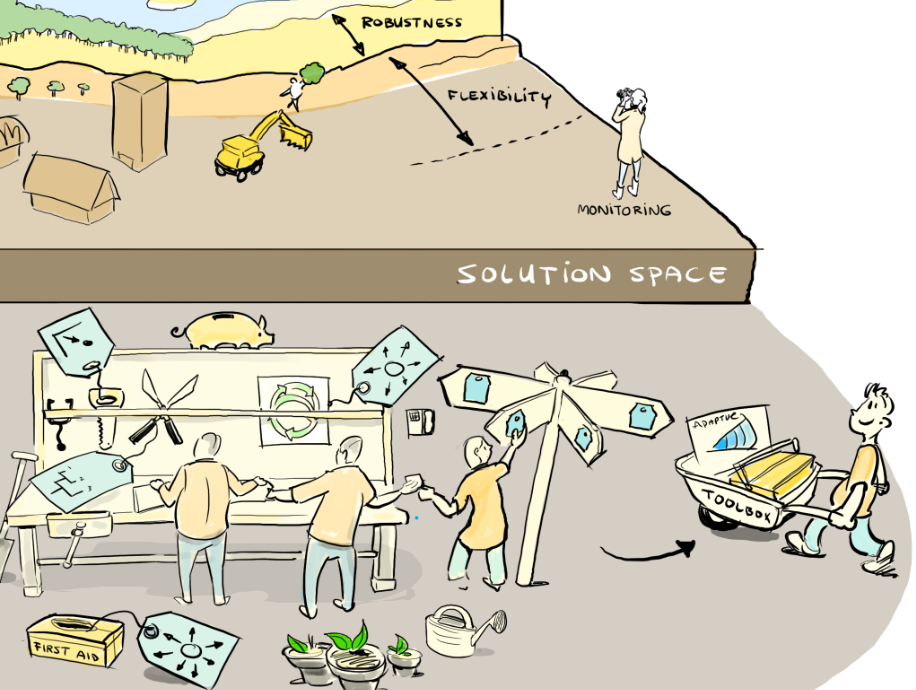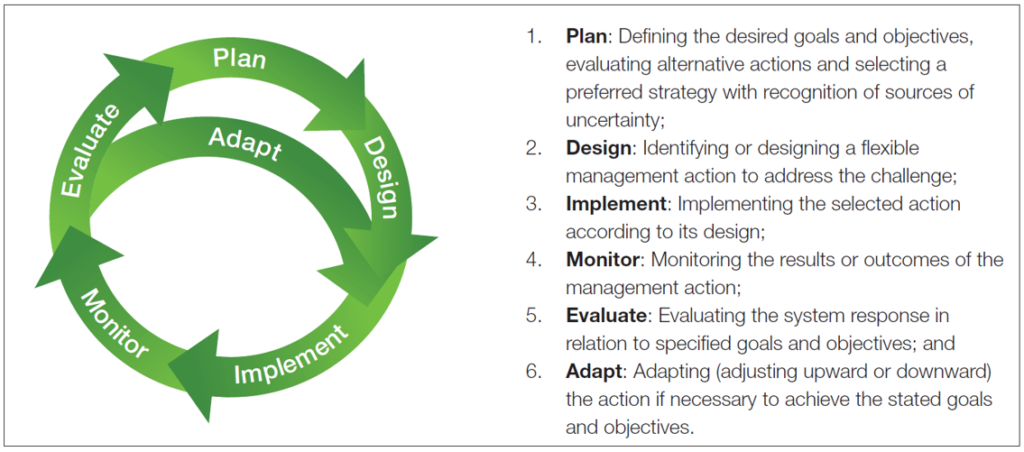Guidance: Balancing design and maintenance efforts
- A balance exists between Building with Nature design efforts and maintenance efforts
- The implementation phase in Building with Nature is typically longer than the construction phase
- Over-dimensioning, diversification and modularity are design strategies to manage uncertainties
- Monitoring and maintenance allows to adapt inherently dynamic Nature-Based Solutions to changing circumstances
Building with Nature designs are dynamic and therefore develop under changing (climatic) conditions. Based from the knowledge out of the six enablers, the challenge is to design Building with Nature Solutions in such a way that the performance of the system is guaranteed, despite the natural dynamics. At the other hand, the solution should preferably be designed such that maintenance efforts are limited. In other words, a balance exists between initial efforts and investments and those needed for adaptive monitoring and maintenance. For example, the initial design of a dune could be higher than prescribed in legislations and thereby reducing required monitoring efforts. Or, in case no legislation and financing constructions are in place to ensure monitoring and maintenance efforts after construction, a strategy with more emphasis on the design is favoured over a strategy with more effort in adaptive monitoring and maintenance. However, it depends on the specific situation at hand which strategy to deal with uncertainties should be applied and to which extent. Selecting the appropriate strategy (or set of strategies) for a specific project depends on aspects from the technical, natural and social system that are present.

Be aware that the time required to reach an objective can differ from the time required for initial intervention. For example, the in case of using mangrove restoration as a coastal defence, the time required for initial intervention might be 1 -2 years, whereas it might take 10-20 years for the mangrove forest to fully develop. Typically Building with Nature is applied on a system scale and the accompanied spatial and time scales require the solution to develop in time after construction. In the next sections design strategies and guidance on monitoring and maintenance frameworks for Building with Nature are presented.
Design strategies: over-dimensioning, diversification, modularity
There are different planning and design strategies that can be employed to cope with or adapt to changing circumstances (Albers and Deppisch, 2013). We distinguish three strategies that can be used:
Over-dimensioning: This strategy implies a redundancy with respect to the units of measurement of the design. For example, as the magnitude of sea level rise is not known as yet, we anticipate and design for the worst-case scenario. For the reinforcement of the Hondsbossche Dunes, this was one of the principles used.
Diversification: This strategy assumes that incorporating many different assets and types of assets as part of the design carries lower risk than a strategy with only a few, similar types of assets. This line of thinking originates from the financial sector, where diversification is a risk management strategy. In the Noordwaard, this strategy was applied were several vegetation species are used to create a ‘robustness’ against disease.
Modularity: This strategy implies that a solution consists of individual, modular components. Modularity gives flexibility as it allows to adapt the solution to changing circumstances. This configuration differs from a solution that consists of (fully) integrated components that are fully integrated. A levee is a solution that consists of fully integrated components where the components (inner layer, outer layer and grass cover) are designed such that they together provide the water retaining function. At the other hand, dunes consist only of individual sand particles (disregarding any vegetation that might be present) . This makes it more easy to adapt the size of dunes by adding new sand particles, “modules”, with nourishments.
Monitoring and maintenance
The adaptive character of Building with Nature comes with a need for continuous monitoring and maintenance to facilitate flexible decision making and ensure the effectiveness of the solution (CEDA, 2015). A monitoring and maintenance framework should be created in an early stage of the project, before choosing between alternatives, as maintenance costs can play a role in the selection process. Upfront there should be an agreement between stakeholders on the content (indicators, trigger levels, actions), processes (roles and responsibilities of involved parties, communication of results) and financing.

To set up an adaptive monitoring and maintenance framework five steps should be taken:
1. Define a baseline (eco)system function: Prior to intervention data should be gathered to set a baseline. The monitoring efforts (intensity and duration) that are required to establish a reliable baseline depend on the level of dynamics in the system.
2. Define the objectives of the Building with Nature solution: The framework should contain a description of the objective of the solution. This objective is often the main target of the design cycle. In contrast to traditional infrastructure, the objective directly after construction might differ from the longer-term objective, because the solutions develop in time. This holds particularly for the development of certain habitat types, that do not develop overnight. A monitoring and maintenance plan should be set in place upfront and not once things are about to move in the wrong direction.
3. identify short-term (during implementation) and long-term monitoring plan to assess functioning of the solution, For traditional infrastructure monitoring is mainly limited to during and around the construction phase to satisfy regulations. Building with Nature comes also with long-term monitoring to monitor the development of the solution. Adaptive monitoring and maintenance should be based on the entire system (physical, natural, social) and not solely the solution itself.
4. identify the key indicators and signal values at which adaptation is required, The monitoring scope (what to measure/where/frequency) should be focused on the intended objective of the solution, but also on a set of plausible scenarios that might negatively influence the solution. The first, focusses on monitoring of the development of the solution to ensure it meets/develops towards the design requirements. The latter addresses potential tipping points. Tipping points can lead to collapse/transition towards a different system state and demand a change in strategy, due to the high impact of tipping points these should receive special attention.
Monitoring of performance objectives focusses on the development of the solution after construction and implementation. Determining the appropriate variables to monitor for tipping points can be challenging, but the aim is to find signals that provide an early, yet reliable indicator of the direction and magnitude of future changes.
5. description of possible adaptations. Ideally the adaptions following exceedance of a signal values are agreed and documented upfront. In case of deep uncertainty this might not always be possible, however organizational actions can be set in place upfront (e.g. gathering of an expert group). For (extreme) events that take place on a rather short timescale (e.g. a high intensity storm, fire) a back-up action plan should be in place upfront, as direct action is required. This allows for adequate decision-making in case of emerging events that endanger the solution’s effectiveness.
An example of these steps in an actual project case is given in the EcoShape project Rehabilitation of mangroves, Demak, Java Indonesia.
| Monitoring and maintenance of permeable structures in Indonesia |
| The pilot case in Indonesia offers an example of successful adaptive management. The design in this pilot used permeable bamboo structures to attenuate incoming waves and trap sediment. Thus, the structures create abiotic conditions that are favourable for mangrove seedling settlement. Since the start of the project early 2015 every autumn permeable structures are constructed by the local community and a lot is learned by doing that and monitoring the construction and the effects afterwards. As natural materials are used, they degrade due to the presence of particular species of worms living off the material and general decomposition. Frequent inspection and maintenance are required and are carried out by the local communities. The natural dynamics and related uncertainties are thereby reduced to a level that is manageable through timely intervention in repair of the structures and that ensures the functioning of the structures as a wave attenuating barrier and trap sediments.  |
Download the white paper
Further reading is available in White paper “a future proof strategy to cope with a changing and uncertain world”, Chapter 3.3
